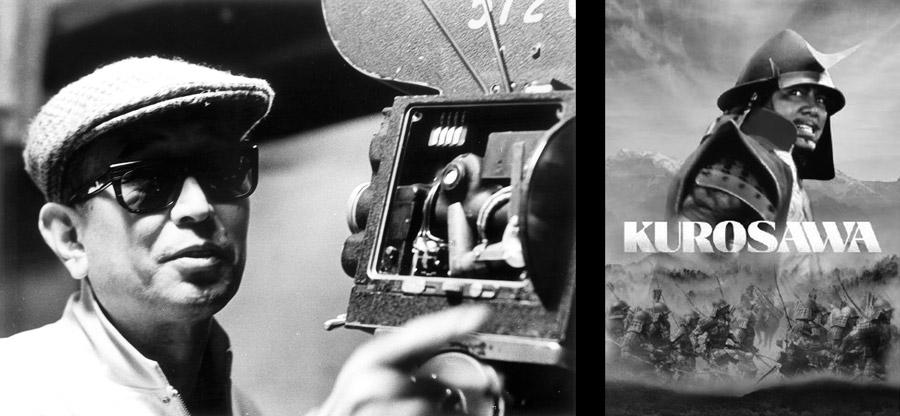The Auteur
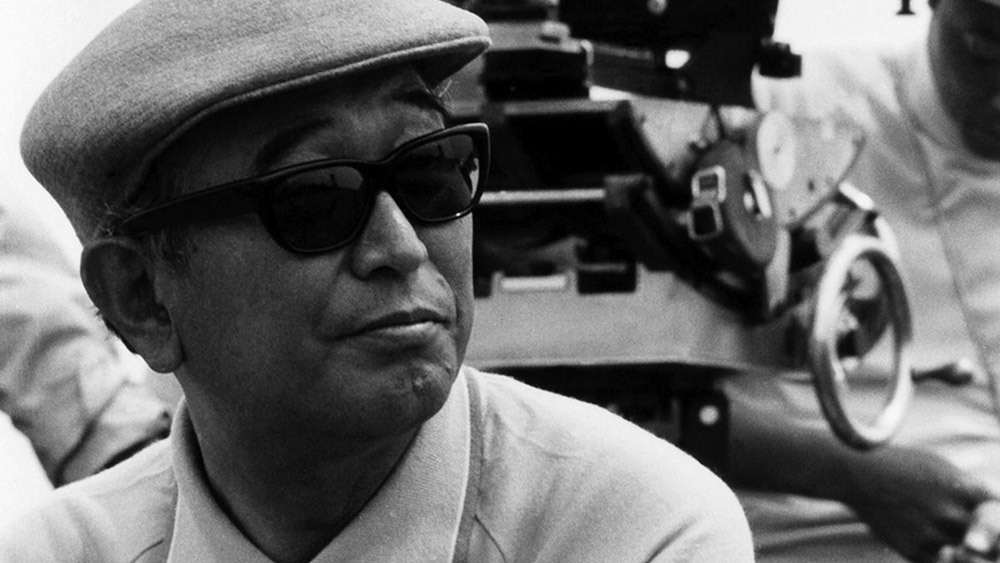
Coinciding with the BFI’s major season on Japanese cinema, we here at Japan Nakama have aspired to create a trilogy of reviews pertaining to some of the films from the late, great Japanese filmmaker, Akira Kurosawa. Celebrating the masterful storytelling of the seminal director and the lingering influence that many of his works weigh on the overall spectrum of film history. Starting with an intrinsic look at his first widely acclaimed piece, Rashomon – focalising on the inherent self-absolution of human nature when one’s fidelity is brought into question – and following up with a brief commemoration of Kurosawa’s most famous film, the pioneering action extravaganza, Seven Samurai.
Over the course of each review, it’s become overtly apparent the monumental impact that Kurosawa’s films have had on the increasingly copycat nature of the movie industry. Just as Kurosawa utilised his deep understanding and affinity for John Ford’s classic westerns of the early-to-mid 20th century – recapturing their narrative essences for his innovative chambara (“samurai cinema”) selection – the director’s films have also been subject to numerous adaptations and thematic homages in the west; establishing a reciprocal chain of cause and effect. A film cycle of influence and reinterpretation.
Oftentimes branded as Japan’s most “Western” auteur, it’s unsurprising that Kurosawa’s films have been routinely echoed and mimicked throughout the western film canon, employing humanitarian themes of peace and virtue amidst exciting plots of courage and violence, formative elements of storytelling that are as universal as the distinction between good and evil itself. Thereby, informing the lasting influence of Kurosawa’s films: that they speak globally and resonate with universal truths of heroism, villainy, selflessness, and selfishness; allowing filmmakers to recapture and pay homage to his seminal masterpieces thanks to the ease of their accessibility. And arguably, none of Kurosawa’s films has been as influential and unjustly copied as that of his 1961 samurai swan song, Yojimbo.
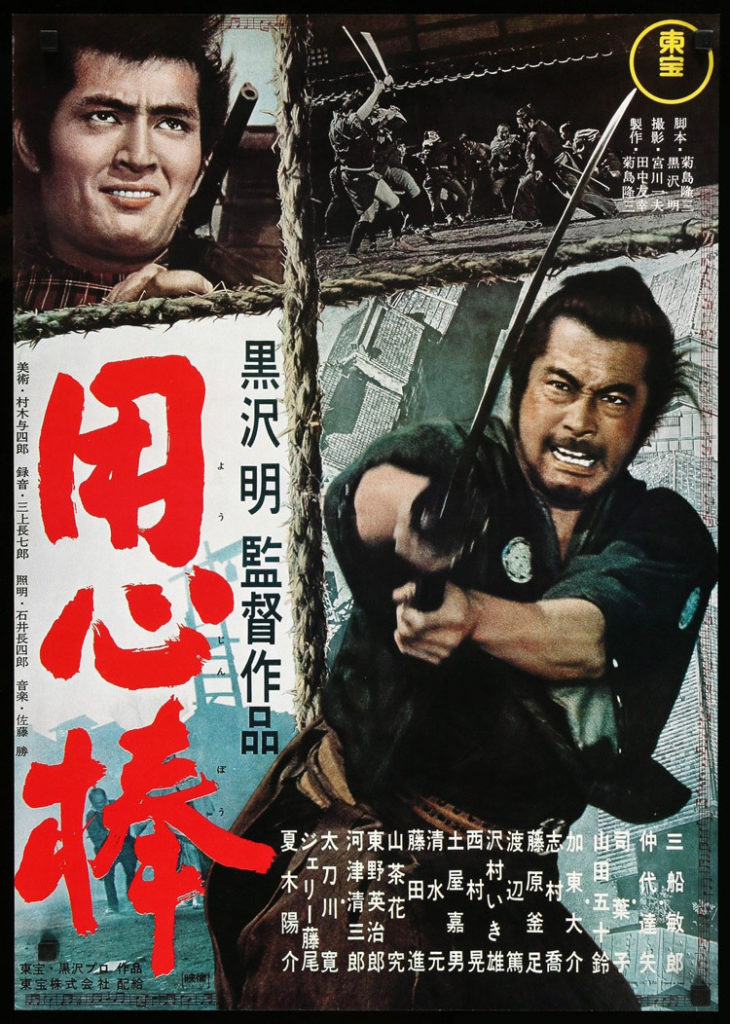
Yojimbo (Bodyguard)
Set in 1860, at the tail end of the Edo period (1603 – 1868), and thus, the demise of the Tokugawa shogunate, in which the samurai were largely exhausted and their importance diminished, Yojimbo tells the tale of a lowly ronin (a samurai without a lord or master) who stumbles upon a town in crisis as two warring factions engage in criminal activities to denounce the other’s control over the townsfolk. Essentially a jidaigeki film about the ill consequences of the two conflicting criminal enterprises, Kurosawa establishes a tale about the seemingly unceasing nature of gangsterdom, as each faction fights to maintain corrupt control over a certain area only to permit more and more irrevocable violence and injustice.
Kurosawa reinforces this thematic with Yojimbo’s swindling central character to the volatile mix; the ambiguously named, Kuwabatake Sanjuro, whose title is merely taken from a nearby Kuwabatake (“mulberry field”) and his ambivalent age (“Sanjuro” meaning “thirty-years-old”). Played cunningly by the great Toshiro Mifune, Sanjuro intends to play both of the criminal gangs against each other, pitting violence against violence as a lesson concerning the meaninglessness of power and domination. Climaxing is a pseudo-superhero finale in which Sanjuro, after witnessing the unending cycle of violence, decides to take on the remaining gangsters to enact a closing act of brutal justice – unsheathing his samurai swords and cutting them down one by one in masterful fashion.
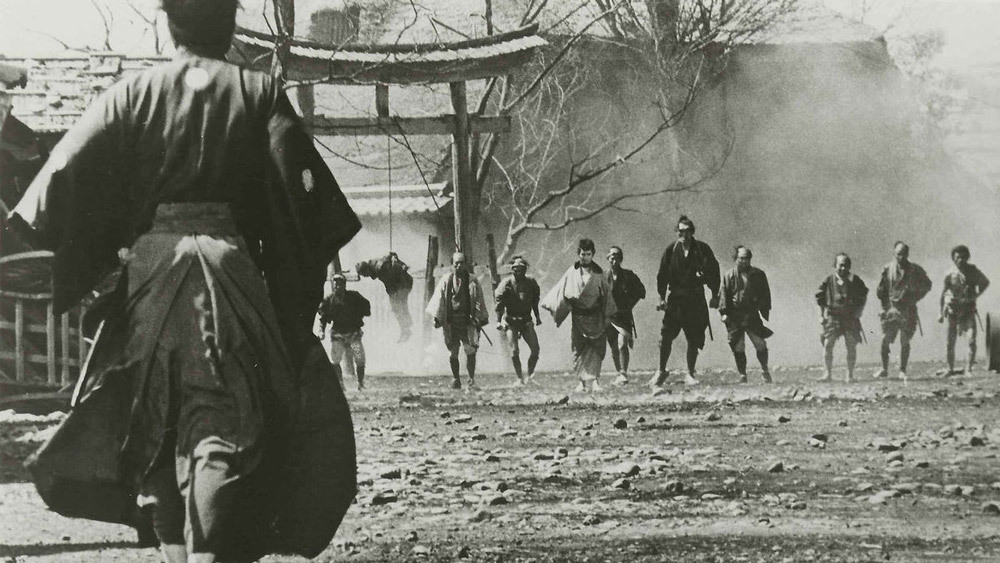
Kurosawa strongly infers his detest for criminal enterprises and the incessant struggle for power between contemporary gangsters, such as the Yakuza, presenting Yojimbo’s villainous lot as dense, brainless and gullible; allowing Sanjuro to play them for fools in a bid for his own benefit. Stating in an interview with Joan Mellen in 1975, Kurosawa openly admits that “[he] was so fed up with the world of Yakuza. So in order to attack their evil and irrationality, and thoroughly mess them up, I brought in the super-samurai played by Mifune. He was himself an outsider, a kind of outlaw, which enabled him to act flexibly, if sometimes recklessly. Only such a samurai of the imagination much more powerful than a real samurai could mess up these gangsters.”
Mifune’s Sanjuro, being free from any master and the final pittance of a dying tenet (the samurai), exacts a story of ultimate inconsequence and irrationality. By pitting each faction against each other, the viewer is shown, in spades, the futility of violence and criminality, and, although exciting and, in part, amusing (thanks to the playfulness in Mifune’s performance and Kurosawa’s writing), the actions relayed are brutal and cruel. And after proving this with the ongoing suffering of the townsfolk, Kurosawa permits a final climax of deserved comeuppance, as Sanjuro – after seeing the forced separation of a mother and child (enacted by the criminal gangs) – enforces true justice upon the villainous gang and their pistol-wielding leader, Unosuke (played by Tatsuya Nakadai).
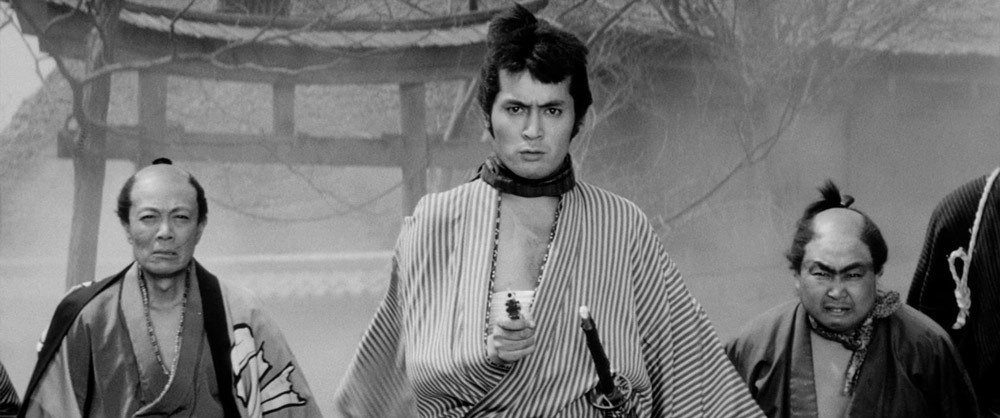
While Kurosawa’s Rashomon attempts to discern the extent of human fallibility, and Seven Samurai that of conviction through strength and the true nature of courage, Yojimbo, on the other hand, tends to dabble with the prospect of bushido, the code of honour historically practiced by samurai and one which Sanjuro arguably fails to meet.
Bushido (meaning “the way of the warrior”) speaks of loyalty, sincerity, frugality, martial arts mastery, and honour until death. Now, while Sanjuro proves his martial arts mastery in spades, the rest of the conglomerate ideals seem misplaced or skewed, as if our broken warrior has all but neglected his status as a samurai. Sanjuro acts without mercy, killing at will to prove his worth; his sincerity is tentative depending on the highest bidder (and even then it isn’t cemented); his frugality seems utterly spent as he attends both criminal gangs looking to further fill his otherwise sparse pockets; and his loyalty is unquestionably nonexistent, enlisting in both gangs and staying loyal to neither as per the aforementioned narrative conflict of the Yojimbo. That leaves Sanjuro’s honour until death, assumedly something that our lonely samurai cannot feasibly achieve, as to maintain one’s honour one must act honourably, which of course, our hero fails to do… until the end of the film.
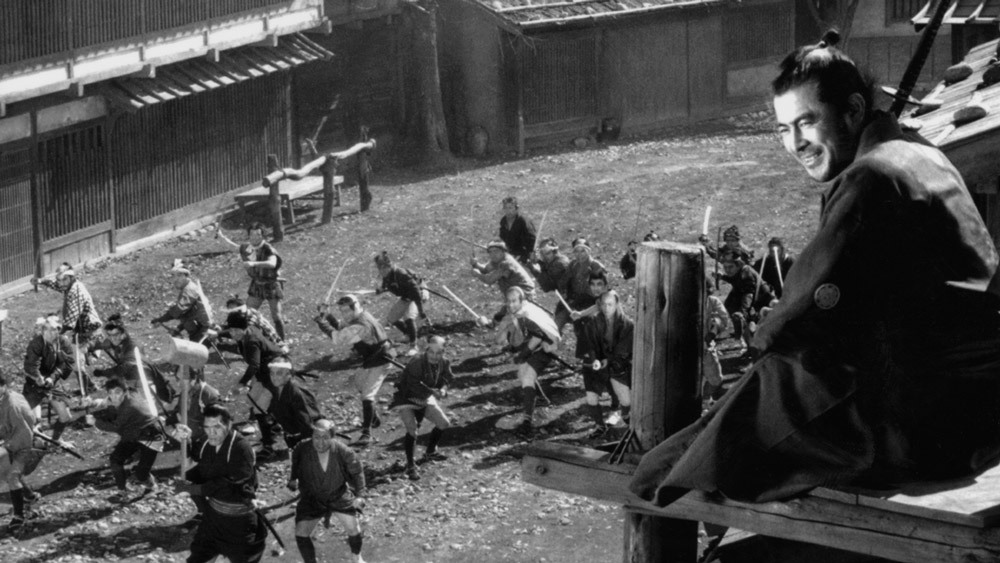
The story of Yojimbo exists at the end of the Edo era in Japan, when samurai were swiftly becoming more and more purposeless and largely lacking use. With the emergence of newfound battle technology in pistols and rifles, the famed Japanese warriors were falling into insignificance – their profound martial arts and lightning-fast swordplay seen as no match for the accuracy and instantaneousness of a bullet in the heart. Samurai were seeping out of existence, and Kurosawa infers that so. The fact that Sanjuro is travelling with no master, and seemingly no plan or perceived objective suggests that he has all but succumbed to the deteriorating need for the samurai. His dismissal to actually help either of the criminal gangs implies a refusal to accept leadership, refuting the way of the samurai and living life by his own hand, or by his own sword. He is the remnants of a dying breed. A ronin with no purpose and no honour, literally throwing a stick and letting its fallen position decide his next direction.
A Fistful of Copyright
Perhaps our samurai’s disillusionment and lack of purpose in Yojimbo is why the movie has been so well recaptured in western cowboy epics as Sergio Leone’s A Fistful of Dollars released in 1964. Sanjuro’s passive violence and refusal to accept any sort of governance is irrefutably cowboy in nature – a silent, brooding outlaw, looking for the nearest buck or the easiest place to rest his head. Leone’s version starring Clint Eastwood as the central warrior is undoubtedly cruel and unchained, only helping those when it suits him or when the pay is good. It’s no wonder that Leone was sued for failing to secure the rights to Kurosawa’s samurai epic, leading to a 3 year delay and a legendary settlement out of court. See here for a side-by-side of Kurosawa’s Yojimbo and Leone’s A Fistful of Dollars.
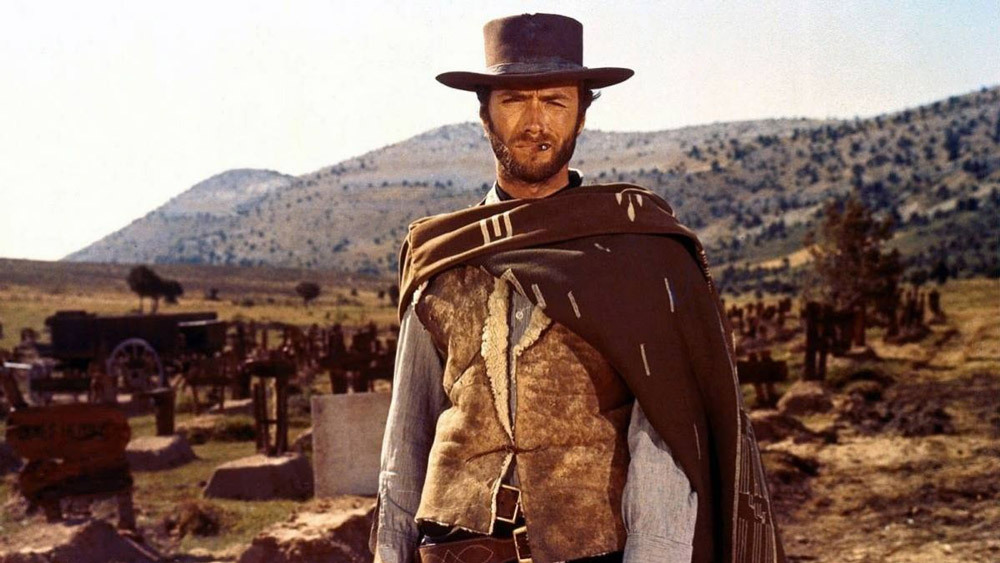
Yet, much like Eastwood’s Man with No Name, it is perhaps the resilient nature of Sanjuro, as a reluctant hero, to only realise his gallantry in the true face of injustice and, at the end of the film, assume his otherwise neglected moral code; finally proving himself worthy of the title of samurai (or cowboy in Eastwood’s case). Striking down the criminal villains after they step too far and begin harassing innocent townsfolk in their unceasing squabble for power. Sanjuro takes up his mythical position as a samurai and acts loyal only to those who can’t fight for themselves. Not for money or shelter but to enact justice on those deserved of such. Sanjuro faces the impending demise of his chosen people, as signified by Unosuke’s pistol, and manifesting his mythical samurai skills once more by striking fear right back into the barrel of the gun.
With marvellous skill, a resurgent moral tenacity and a typical cinematic opulence, Kurosawa permits one final act of honourable virtue, allowing our protagonist to assume his bushido once more and adopt the way of the Samurai (at least for a moment). Leaving Sanjuro thus, to venture forth back into the country in continuation of his nonchalant search for validity and his, somewhat reserved, penchant for justice. In Sanjuro’s case, it’s just that: Kurosawa’s 1962 sequel to Yojimbo, justifiably titled Sanjuro; featuring another party in crisis, and again starring Mifune as the titular character and mythical ronin.
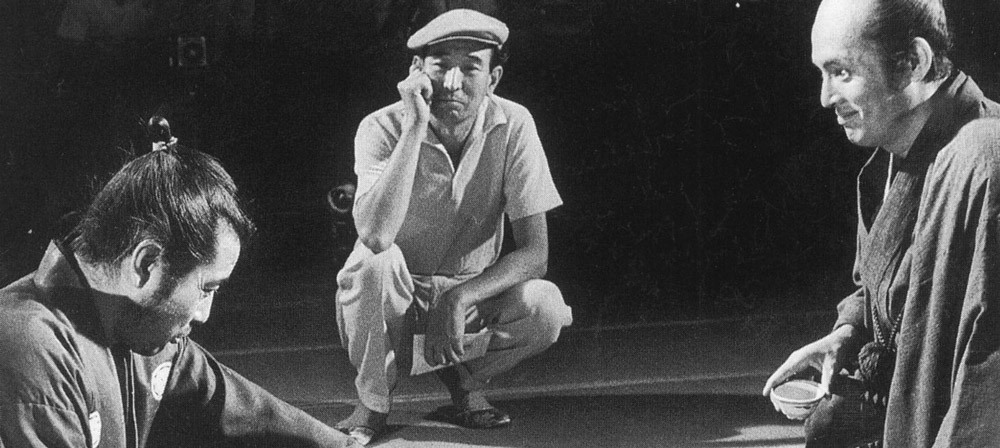
Sayonara, Samurai
And with that, we end our three-part run on a select few of Akira Kurosawa’s legendary jidaigeki-chanbara films. Detailing the collective impact that they impelled on the world of western film, as well as the monumental resonance of each of their particular and diverse narratives. Yet, as per the myriad masterpieces in Kurosawa’s repertoire, there’s so much more to see.
















































